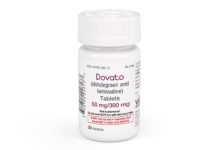A second-line HIV regimen containing the integrase inhibitor raltegravir failed to meet its primary endpoint of noninferiority against standard second-line treatment with nucleoside reverse-transcriptase inhibitors, or NRTIs, according to 144-week data from the EARNEST trial.
James G. Hakim, FRCP, of the University of Zimbabwe Clinical Research Center, and colleagues said their findings have “important implications for second-line therapy in the public health approach” to HIV.
The good longer term outcomes with the combination of a protease inhibitor (in this case lopinavir) with two NRTIs provides support for this regimen as the WHO-recommended preferred second-line combination, – they wrote in The Lancet Infectious Diseases.
Although WHO recommends NRTIs as part of standard second-line therapy, the world health agency’s 2016 guidelines include raltegravir as an alternative option. To determine whether the drug offered any additional benefit over NRTIs, Hakim and colleagues compared the outcomes of 1,277 patients no longer responding to first-line ART in sub-Saharan Africa who were randomly assigned to a regimen containing:
- 400 mg of lopinavir plus 100 mg of ritonavir twice daily and two to three clinician-selected NRTIs (n = 426);
- 400 mg of raltegravir and protease inhibitor twice daily (n = 433); or
- protease inhibitor monotherapy with an initial 12-week induction of raltegravir and reintroduction of combination ART after 96 weeks (n = 418).
The researchers hypothesized that the protease inhibitor plus raltegravir regimen — two new active drug classes — would be superior to a regimen containing NRTIs. The primary outcome was a viral load less than 400 copies/mL at week 144.
At the end of the study period, the proportion of patients with viral loads less than 400 copies/mL was 86% in the protease inhibitor plus NRTI group vs. 81% in the protease inhibitor plus raltegravir group. Although the raltegravir-containing regimen did not meet the 10% noninferiority margin, it was not significantly inferior to the NRTI-containing regimen. In the protease inhibitor monotherapy group, 78% of patients had less than 400 copies/mL.
There were no significant differences in the incidence of serious adverse events, grade 3 or 4 adverse events or events that led to treatment modifications, according to the researchers. In the protease inhibitor plus raltegravir group, 7% of patients had resistance to raltegravir and 3% had resistance to lopinavir. In the control group, 3% of patients had resistance to one or more NRTIs and 2% had resistance to lopinavir. Among those who received protease inhibitor monotherapy, 11% had resistance to lopinavir.
Taking into account the higher cost of raltegravir, the absence of clear advantages of protease inhibitor plus raltegravir seen in any trial and the failure to show noninferiority consistently across all analyses after 144 weeks of treatment in this trial suggest that there is no compelling reason for national programs to adopt this combination as the standardized second-line therapy in the public health approach to [ART].
The researchers suggested that dolutegravir — an integrase strand transfer inhibitor with a high genetic barrier to resistance and longer half-life than raltegravir — may be more suitable for second-line therapy in resource-limited settings.
The results from EARNEST and other similar clinical trials suggest that NRTIs will retain efficacy in second-line treatment when used with protease inhibitors. We now need to ensure that this protective effect also allows newer drugs such as dolutegravir to be used with recycled NRTIs in second-line treatment.
Raltegravir is sold under the brand name Isentress (Merck). Lopinavir/ritonavir is sold under the brand name Kaletra (AbbVie).
Stephanie Viguers


 ПОИСК ПО САЙТУ
ПОИСК ПО САЙТУ  поиск по ресурсному центру
поиск по ресурсному центру 



